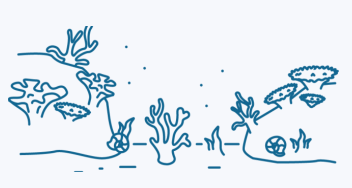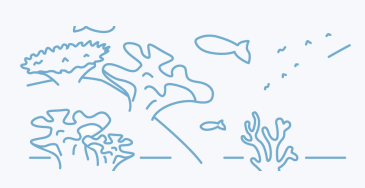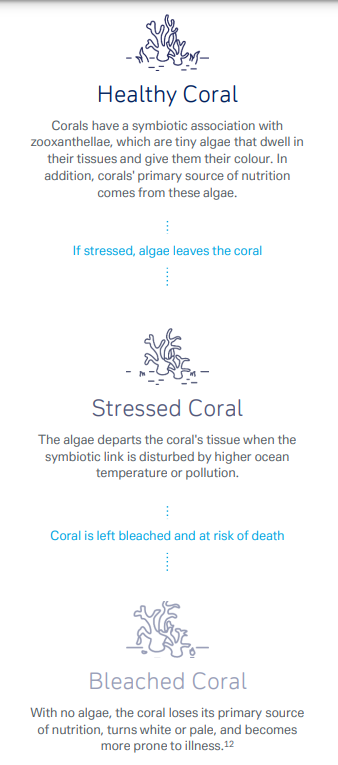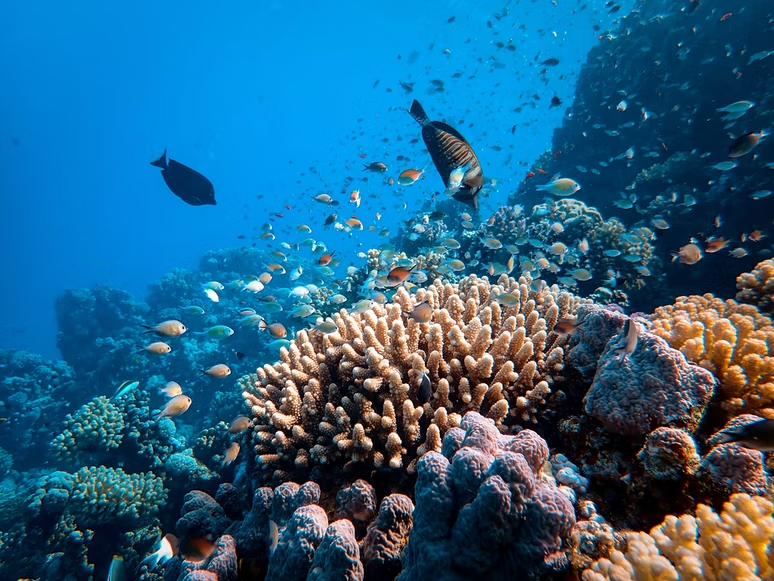· 6 min read
Corals: beauty and benefits
Biodiversity is all around us, in ways we can see and appreciate, as well as ways we can’t. Even urban citizens will be aware of the importance of trees. But few of us will either see the full glory of coral reefs or be aware of how deeply we depend on them.
Up to a billion people worldwide benefit on a daily basis from the revenue generation, protection and food security granted by coral reefs[1] . Small island states and many developing countries are depending on coral reefs. Nearly 200 million people around the world make a living through fishing, with coral reef fisheries valued at USD6 billion and 6 million coral fishers[2][3]. They contribute approximately USD30 billion to world GDP each year[4].
Corals are not only beautiful to look at but provide refuge and homes for thousands of other species. In fact, while coral reefs cover less than 1% of the ocean, they sustain 25% of all marine life[5] . They provide, for example, nursery grounds for species that are of great commercial fishing importance[6].
Coral reefs also protect coastlines, providing self-repairing breakwaters. Healthy coral reefs can dramatically reduce incoming wave energy. Problems here have major implications. Even a one meter loss of coral reef height can double the damage done to the shoreline and triple the costs from an extreme weather event[7]. Without reefs, the cost of damages done by 100-year storm events could almost double[8].
Reefs may help us in other ways, and not just through their touristic appeal. They can for example provide medicinal compounds with potential uses in treatments for cancers, Alzheimer’s and numerous other diseases like arthritis and bacterial infections.
What makes a coral reef?
Corals are living, ocean-dwelling animals. Each individual coral exists as a colony consisting of multiple small, identical coral polyps. Wherever corals make up the foundation of an underwater habitat, a coral reef occurs. Coral reefs are complex marine ecosystems that include diverse collections of colourful fish and other sea creatures. But what is it that allows corals to grow and support so much wildlife?
One coral is composed of many polyps
All coral colonies are made up of polyps, which are their basic building blocks. Corals need them to grow, feed, and breed, resulting in a varied and colourful ecosystem.

Corals build coral reefs
Corals need calcium and carbonate from saltwater to create their skeleton. Both corals’ structures as well as the overall architecture of the coral reef is provided by this skeleton.

Coral reefs supply both food and protection.
Corals are the foundation of a complex food chain that permits marine life to thrive on coral reefs.[9]

Why corals are at risk
Corals are animals not plants. The soft polyps within the hard sections of corals are inherently transparent, and the algae that lives inside them gives them their brilliantly vivid hues.
When corals are disturbed – due to high temperatures or pollution – they often expel this algae and turn white. Such “bleached” corals are still alive but vulnerable, being in effect immunocompromised. Many starve and die, then turning a dark brown colour.
Sadly, we are currently experiencing the longest global coral bleaching event ever observed[10]. Warmer ocean temperatures as a result of unusual ocean currents are the main culprit.
Repeated or extended bleaching events can kill off reefs that have taken centuries to form. The Intergovernmental Panel on Climate Change (IPCC) has warned that if global warming hits the 1.5°C target, 75-90% of the world's coral reefs could die off[11]. A 2°C warming could make all tropical corals extinct.
Corals and algae are mutually dependent on one another to thrive.

What causes coral bleaching
Overexposure to sunlight
When temperatures are high, high solar irradiance contributes to bleaching in shallow-water corals.
Change in ocean temperature
Climate change-induced increases in ocean temperatures are the major cause of coral bleaching
Runoff and pollution
Storm generated precipitation can rapidly dilute ocean water and runoff can carry pollutants – these can bleach near-shore corals.
Extreme low tides
Exposure to air during extreme low tides can cause bleaching in shallow corals[13].
What we can do
There are many practical things we can do to help coral reefs. We can improve the habitat quality for corals and improve corals’ resilience. We can reduce humans’ direct effect on reefs (e.g., via excessive tourism) and can better use planted corals in to help safeguard coastal areas. We know how to do some of this.
We know how to directly implant coral fragments on reefs, for example, or “garden” corals via nursery cultivation before replanting on the reef. Larvae propagation, before they are released to connect to a reef, is also possible. We make it easier for coral reefs to coexist with coastal protection measures (e.g., rock armouring, seawalls, and shore constructions). Some of these measures will be local and some will be global. Some will be engineered, and others will be nature-based. We will need a multi-pronged approach which takes a hard look at the efficiency of every dollar spent.
But what we also need to is a greater understanding. The gaps in scientific knowledge around coral are substantial. We would like to help fill in some of these gaps and therefore the first initiative that will be financed by our DB Ocean Resilience Philanthropy Fund is the Future Climate Coral Bank. This is a research project in the Maldives led by The Maldives Coral Institute (MCI). It is designed to identify coral species that are resilient to climate change and conserve them in a living gene bank. Taking advantage of recent technological developments, this project is at the cutting edge of international efforts to find ways of boosting reef resilience to improve the prospects of coral-dependent communities in the future. We are sure that our clients will want to support such essential research.
This article is also published by the Deutsche Bank CIO Office . Energy Voices is a democratic space presenting the thoughts and opinions of leading Energy & Sustainability writers, their opinions do not necessarily represent those of illuminem.
Footnotes
1. Hoegh-Guldberg, O., Pendleton, L., Kaup, A. (2019). People and the changing nature of coral reefs. Regional Studies in Marine Science. 30. 100699. https://doi.org/10.1016/j.rsma.2019.100699 Beck, M. W., Losada, I. J., Menéndez, P., Reguero, B. G., Díaz-Simal, P., & Fernández, F. (2018). The global flood protection savings provided by coral reefs. Nature communications, 9(1), 1-9. https://doi.org/10.1038/s41467-018- 04568-z.
2. People and the changing nature of coral reefs. Retrieved from: https://www.sciencedirect.com/science/article/pii/S2352485518306637. July 2019.
3. Global decline in capacity of coral reefs to provide ecosystem services. Retrieved from: https://www.sciencedirect.com/science/article/pii/S2590332221004747. September 17, 2021.
4. UNEP, The Coral Reef Economy Report. Retrieved from: https://www.unep.org/resources/report/coral-reefeconomy#:~:text=The%20analysis%20found%20that%20a,respectively%2C%20between%202017%20and%202030. November 13, 2018
5. UNEP, Life Below Water. Retrieved from: https://www.unep.org/interactive/status-world-coral-reefs/. 2020.
6. Coral Reefs of the High Seas: Hidden Biodiversity Hotspots in Need of Protection. Retrieved from: https://www.frontiersin.org/articles/10.3389/fmars.2020.567428/full. September 14, 2020.
7. Maldives Coral Institute, 5 Year Strategic Plan, maldivescoral.org.
8. The global flood protection savings provided by coral reefs. Retrieved from: https://www.nature.com/articles/s41467-018-04568-z. June 12, 2018.
9. National Oceanic and Atmospheric Administration. Retrieved from: https://coralreef.noaa.gov/gallery/infographic/makes-coral-reef.html.
10. National Oceanic and Atmospheric Administration. Retrieved from: https://www.noaa.gov/media-release/el-ni-o-prolongs-longest-global-coralbleaching-event#:~:text=The%20first%20global%20bleaching%20event,a%20less%20powerful%20El%20Ni%C3%B1o. February 23, 2016.
11. Intergovernmental Panel on Climate Change (IPCC): Global warming of 1.5°C. Retrieved from: https://www.ipcc.ch/site/assets/uploads/sites/2/2019/06/SR15_Full_Report_Low_Res.pdf. 2018.
12. National Oceanic and Atmospheric Administration. Retrieved from: https://oceanservice.noaa.gov/facts/coral_bleach.html.
13. WWF. Retrieved from: https://www.worldwildlife.org/pages/everything-you-need-to-know-about-coral-bleaching-and-how-we-can-stopit#:~:text=The%20leading%20cause%20of%20coral,pollution%2C%20or%20too%20much%20sunlight






